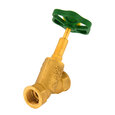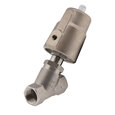Sanitary Angle Seat Valves
Figure 1: Sanitary angle seat valves are used in food processing industries for precise flow control
Sanitary angle seat valves are pivotal components in the control of flow processes within hygienic and aseptic applications across various industries, including food and beverage, pharmaceuticals, and biotechnology. These valves, known for their durability, high cycle life, and minimal pressure loss, are designed to meet stringent sanitary standards, ensuring process integrity and product quality. This article explores the main features, design details, standards, and the specific applications that necessitate the use of sanitary angle seat valves.
View our online selection of angle seat valves!
When to buy a sanitary angle seat valve
Sanitary angle seat valves are the ideal choice in scenarios where:
- Hygienic conditions are required: In industries like food and beverage, pharmaceuticals, and cosmetics, where product purity and safety are critical.
- Steam or aggressive cleaning is used: Where the process involves steam sterilization or the use of aggressive cleaning agents, necessitating corrosion-resistant materials and cleanable designs.
- High viscosity fluids are involved: Sanitary angle seat design allows for efficient handling of high viscosity fluids without significant pressure drops.
Sanitary angle seat valve features
Here are some key features and benefits of sanitary angle seat valves:
- Easy cleaning and maintenance: Sanitary angle seat valves are designed for easy cleaning and maintenance. Their smooth surfaces minimize potential entrapment of media, and many have features like self-draining designs to prevent pooling of liquids. Disassembly for cleaning is often straightforward due to their modular construction. This durability is particularly valuable in high-throughput environments where downtime for repairs or replacements can be costly.
- Precision flow control: Sanitary angle seat valves are not just on/off devices; they offer exceptional control over flow rates. This precision is achieved through the design of the valve seat and the actuator, allowing for fine adjustments to the flow, which is essential in processes requiring accurate balance, such as dosing and filling operations.
- Adaptability to aggressive media: The material selection and design of sanitary angle seat valves allow them to handle aggressive media, including corrosive fluids, without compromising the valve's integrity or the system's sanitation. This adaptability is crucial in industries where harsh ingredients or cleaning agents are the norms, such as in certain chemical processing or cleaning applications.
- Quiet operation: Quiet operation in sanitary angle seat valves, especially pneumatically actuated type, is achieved through features like soft start/stop which gradually applies air pressure, reducing the noise during opening and closing. Additionally, some valves employ design elements like minimized internal clearances and damping materials to further suppress noise generation.
Applications
Sanitary angle seat valves are crucial in various industries for their ability to maintain high hygiene and sterility standards. Typical applications include:
- Biopharmaceutical industry: Used for sterile processing and controlling the flow of sensitive substances, ensuring product integrity.
- Food processing: Essential for managing ingredient flow and maintaining cleanliness in production lines, crucial for food safety.
- Beverage and dairy: Employed in dosing, filling, and liquid flow regulation processes to prevent contamination and maintain product quality.
- Personal care and cosmetics: Utilized for accurate dosing and packaging, ensuring the purity of personal care products for consumer safety.
Design considerations for sanitary angle seat valves
Sanitary angle seat valves are distinguished from their standard counterparts by several design features tailored to meet hygienic requirements:
- Body material: Typically manufactured from stainless steel, the valve body in sanitary applications is polished to prevent any bacterial growth and ensure easy cleaning.
- Seals and gaskets: Utilizing FDA-approved materials such as PTFE (Teflon) for seals and gaskets, these valves ensure a high level of hygiene and resistance to aggressive cleaning agents. Some manufacturers offer replaceable seat inserts. This allows for easier and more cost-effective maintenance compared to replacing the entire valve body if the seat becomes worn or damaged.
- Connection types: Sanitary applications typically use clamp, flange, or threaded connections designed for easy assembly and disassembly. Tri-clamp fittings are particularly popular in sanitary applications for their ease of cleaning and secure, leak-free connections.
- Temperature and pressure resistance: Designed to operate across a wide range of temperatures and pressures, sanitary angle seat valves can handle the steam and hot water used in cleaning processes, as well as the operating conditions of different process media.
- Surface finish: The internal and external surfaces of the valve are polished to specific surface finish standards (e.g., Ra < 0.8 µm) to prevent product buildup and bacterial contamination. The term "grit" measures the number of scratches per linear inch on an abrasive pad, with higher numbers indicating a smoother finish. "Ra," or Arithmetic Mean, measures the average value of the surface's peaks and valleys, with lower numbers signifying a smoother finish (Table 1). Surface treatment plays a crucial role in ensuring sanitary valves are suitable for clean and sterile applications.
For the food-processing, dairy, and beverage industries, the standard interior surface finish is 32Ra. This benchmark is established by the 3A organization, which sets standards for the dairy industry, and represents the minimum standard for piping.
The pharmaceutical industry employs a broader spectrum of surface finishes, tailored to the specific requirements of the end user. Most pharmaceutical companies now follow the ASME BPE standards, which outline seven different surface finishes. These include four levels for mechanically polished fittings/tubing and three levels for those that are both mechanically polished and electropolished.
Table 1: Surface finish standards by abrasive grit size
| Grit | Max Ra (micrometer) | Max Ra (microinch) |
| 120 | 1.01 - 1.14 | 40 - 45 |
| 150 | 0.68 - 0.80 | 27 - 32 |
| 180 | 0.46 - 0.58 | 18 - 23 |
| 240 | 0.34 - 0.46 | 14 - 18 |
| 320 | 0.23 - 0.28 | 9 - 11 |
Standards and certifications
Sanitary angle seat valves adhere to a variety of standards and certifications to ensure they meet the rigorous requirements of hygienic processes:
- 3-A sanitary standards: Widely recognized in the food and beverage industry, these standards ensure that valve design facilitates cleanability and bacterial control.
- EHEDG (European hygienic engineering & design group): Certifications from EHEDG indicate that the valves are designed for easy cleaning and sterilization.
- FDA (Food and drug administration): Compliance with FDA regulations for materials that come into contact with food products is crucial.
- ASME BPE (bioprocessing equipment): Standards for bioprocessing equipment that include details on materials, design, and fabrication for biopharmaceutical applications.





